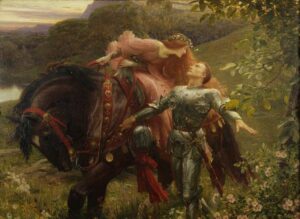As someone who loves words and the way they try to express the inexpressible, I absolutely love Alfred Tennyson’s Canto V of his In Memoriam. The diction, cyclical structure, and juxtaposition of words in the poem perfectly encapsulates Tennyson’s feelings of grief, especially how even though the experience of writing can be calming and explorative, it will never let him escape.
Told in three stanzas of ABBA rhymes, the structure of the canto is very simple. It is a parallel structure (split in two, with the inverse of AB to BA), and feels very monotonous and repetitive. This repeated structure, kept up throughout In Memoriam, speaks to its purpose as a “mechanic exercise,” duplicated over and over (Line 7). One could almost think of it as a Mad Libs, with the structure concrete and the words interchangeable. This cyclical structure indicates the cyclical nature of his feelings of grief and how they’re essentially inescapable for him. He keeps going around and around, writing these poems and never really moving on. However, I think this predictable poetic structure allows for deep thought into what words are put where. The medium of words and their interchangeability allow him to safely explore these repetitive feelings.
For example, in stanza two, the use of “measured” and “mechanic” in lines 6 and 7 respectively, draws the two lines even closer together in meaning, in addition to the B rhymed endings of those lines. Both words imply a sort of slow, unchanging rhythm, which applies to both the content of the poem and the poem’s form itself. The fact that these two words are also stacked right on top of each other on the page draws the two together. In the same stanza, Line 5 mentions the “unquiet” heart, while Line 8 talks about it being “dull” and “numbing.” The juxtaposition of these two adjectives gives the poem a linear flow, showing the evolution of his feelings despite the repetitive nature of the exercise. To me, the word choice and placement of these adjectives heightens the content of the stanza itself, which speaks on how writing these poems allows Tennyson to numb the pain of his grief. The pairing of content and form really heightens the impact of this poem.
Furthermore, to analyze the lines of the poem itself, they reveal Tennyson’s agitation at how the words can only express a small part of his grief, and yet it is soothing to write them. The poems can only ever “half reveal” the depth of his feelings, and end up “half conceal[ing] the Soul within” (Line 3, 4). Whatever he does, whatever he writes, there will always be something that is not, perhaps cannot, be translated onto the page. Even with the adaptability that the structure allows, any words and phrases he chooses will never reveal the entire truth. Nevertheless, this “measured language” and “exercise” allows him to dull the pain and perhaps even process his grief (Line 6, 7).
By imagining himself in these different situations – as a lover waiting for his beloved (VII), a widower in her marriage bed (XIII), or waiting at the port for his friend to return alive (XIV) – Tennyson can explain and process his own grief through metaphors that help a reader understand. At once, it is an explanation and a discovery. And even though these will only provide an “outline and no more,” they are nevertheless capable of helping Tennyson in his grief (Line 12). This ‘outline’ gives shape to the complicated mess of his emotions and allows Arthur’s legacy to live on.
As he explains in the final stanza, the words “wrap me o’er” and guard him “against the cold,” providing comfort and protection from the overwhelming wave of grief that is threatening to overtake him (Lines 9, 10). Even though it is painful and perhaps futile to write these poems, Tennyson says he will continue anyway, because, almost like “narcotics,” he is addicted to the relief it gives him (Line 8). I think it is really interesting how Tennyson uses writing itself, specifically its structure and word choice, to explore his own feelings.

